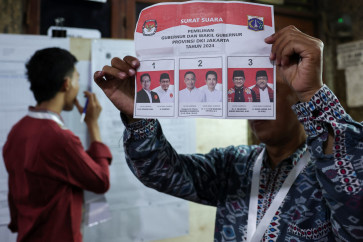Popular Reads
Top Results
Can't find what you're looking for?
View all search resultsPopular Reads
Top Results
Can't find what you're looking for?
View all search resultsGHG emissions reduction: Switching off climate change
President Susilo Bambang Yudhoyono has committed Indonesia to make substantial cuts in emissions of greenhouse gases
Change text size
Gift Premium Articles
to Anyone
P
resident Susilo Bambang Yudhoyono has committed Indonesia to make substantial cuts in emissions of greenhouse gases. Several studies have been commissioned which recommend this.
Others aim to set out what to do. All, in one way or another, rely on the official United Nations report on assessments of climate change.
But there are now serious doubts about the scientific soundness of those assessments.
In what has been dubbed “Climategate”, it was revealed that leading climate change scientists have manipulated data in the official reports of the Intergovernmental Panel on Climate Change (IPCC) — the UN’s official adviser on climate science. The IPCC has been publicly embarrassed and has ordered a review of its processes.
Six months ago most political leaders felt bound to take action to reduce emissions. The politics have suddenly changed.
Recent opinion polls in the US and Britain show people are becoming less convinced of the need for drastic action on climate change. There is now new political sensitivity to the high cost of cutting greenhouse emissions.
This is a time when prudent people would take extra care about claims about the impact of global warming. The World Wide Fund for Nature (WWF) apparently sees things differently.
This week it is urging that everyone in Jakarta turn their lights off for an hour on Earth Day (March 27) to “change the world in one hour”. This is a global campaign.
According to WWF, 300 megawatts/hour less power will be consumed, saving 267 trees and creating cleaner air for 535 people.
Let’s assess these numbers at face value. With trillions of trees and 220 million people in Indonesia, these changes are so tiny that a statistician would rate them at zero. How can this “change the world”?
But there’s something else. It is the nation’s electricity utility, not the consumers of electricity, which emit greenhouse gases.
The generators will not be powered down during Earth Hour. Because a power grid cannot predict how much consumption will vary in that hour, it is most likely to keep its generators operating during Earth Hour even if they do not need to produce electricity. Only in this way can it is able to meet demand from hour to hour.
So it is hard not to form an opinion that WWF is less interested in the technical or scientific accuracy of what it says, than to create a fanfare. We should not be surprised at this. WWF’s approach to forestry in Indonesia for over a decade leads one to the same view.
In 1997, one year before WWF established a permanent presence in Indonesia, Danish environmentalist Bjorn Lomborg showed that claims by the president of WWF International that the forest fires that year in Indonesia were the worst on record were simply not true.
He also showed WWF’s assessment of how much forest was burnt was significantly in error.
This fanfare appeared to presage the launch of WWF’s long-running campaign to halt expansion of forestry and plantation industries in Indonesia.
Little has changed. Today, WWF uses data on forest fires from that earlier period to show rates and causes of deforestation in Indonesia that do not stand scrutiny.
Analyses produced two years ago to demonstrate a large carbon footprint in Jambi province from the forest sector relied on hearsay and arbitrarily discounted the sequestration of carbon by natural forests, rather using sound technical analysis.
The forest industry protested these claims, pointing out, as the Food and Agricultural Organization has for years, that the biggest drivers of illegal logging and deforestation in Indonesia were independent operators and poor smallholders. WWF continued to solicit funds from its donors and aid agencies. Environmental campaigners typically dismiss counter comment from the forest industry as “just what you would expect to hear”.
The recent Climategate revelations support the perception that WWF is also guided more by fanfare than fact on climate change.
The London Telegraph found no less than 16 WWF reports made claims which were used as sources for the UN reports which did not meet the scientific standards of the UN body.
The most notorious was reliance on a claim in a WWF report, for which there was no dependable scientific support, to demonstrate that climate change was accelerating the shrinkage of glaciers in the
Himalayas.
The issue here is not a quibble over numbers. WWF’s research is highly influential. It contributed to the widely publicized claim, since disavowed by the Indonesian government, that Indonesia is the third largest emitter of greenhouse gases. Research by World Growth has confirmed that Indonesia’s response is correct.
Despite this, the claim is still used, even by the British Government, to justify expensive and growth-sapping measures to reduce emissions.
WWF reports are also used to support bids for funding from aid donors and foundations to support its programs.
Generally donors prefer to support on-ground conservation rather than advocacy. What has WWF delivered in Indonesia apart from anti-forestry tirades?
It has a number of small, but useful, animal conservation programs. Its conservation showpiece is Tesso Nilo National Park’s expansion to 100,000 hectares in Sumatra.
This has not been successful. Forest land encroachment for livelihood plantings and illegal logging by local communities are rampant within the park.
Despite this, has continued to incorrectly label large plantation and forestry companies as the primary threat to the park. Rather than get its own house in order and fix Tesso Nilo’s existing problems, WWF has been lobbying national and local governments to have the park expanded.
The question here is, if poor communities within the existing national park boundaries cannot be managed currently, how will an even larger park fare?
While WWF professes that real conservation is its primary business, its activities indicate that what drives the organization is what it calls advocacy (i.e. creating fanfare). Some donors, like the European Union (EU), directly support the goal of constraining forestry and support WWF advocacy for that.
Like WWF, the EU gives no public recognition of the fact that around 25 percent of Indonesian forest and over 50 percent of Malaysian forest is already reserved, or that forest conversion on land earmarked for development creates jobs and reduces poverty.
Those motivated to see real conservation results however might be more circumspect. Climategate reveals that WWF’s reputation as a conservation organization is at risk. It needs to show it has done something to improve the standard, quality and veracity of its technical work.
Meanwhile, its Earth Hour website suggests it is business as usual. It sports an electronic invitation to make a financial contribution to the WWF campaign.
Recent opinion polls in the US and Britain show people are becoming less convinced of the need for drastic action on climate change.
The writer is chairman of World Growth, a US-based NGO.










